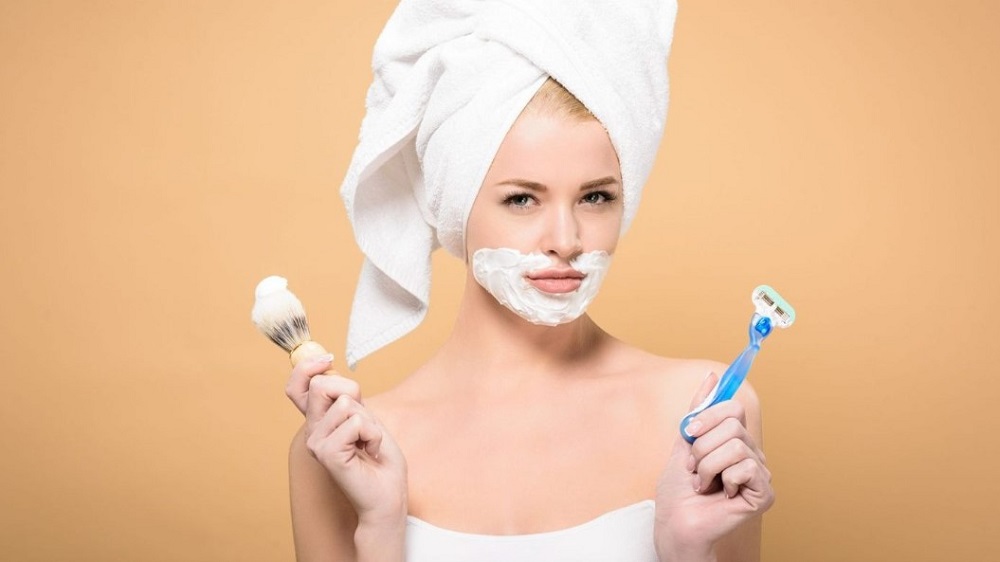Let’s talk about a topic girls may find odd: face shaving for women. Our world has evolved in grooming and self-care beyond gender norms, and it’s time to have an open conversation about this subject.
While the idea of women shaving their faces might seem unconventional, it’s a practice that’s gaining popularity for its numerous benefits.
From achieving smoother, more radiant skin to improving makeup application, face shaving can be a game-changer.
However, like any beauty ritual, there are rules to follow. Let’s explore face shaving for women, the symptoms that can arise when things go awry, and the do’s and don’ts to help you practice this self-care regimen safely.
Why Do Women Need to Shave Their Faces?
Firstly, you should understand the need for face shaving for women. There can be several reasons, including:
Peach Fuzz Removal
One of the primary reasons women turn to face shaving is to remove that fine, barely noticeable hair on the face, often referred to as “peach fuzz.”
This subtle hair can be more bothersome than you’d expect, as it can trap makeup, making it appear uneven or cakey.
Face shaving creates a smooth canvas for makeup application.
Exfoliation
Shaving acts as an exfoliation method. It removes dead skin cells, makes the skin dull, and can lead to clogged pores.
Shaving reveals a fresh layer of skin, promoting a radiant complexion.
Enhanced Product Absorption
Skincare products are more readily absorbed by the skin after shaving. It is because there is no longer a barrier of hair to prevent direct contact with the skin.
Anti-Aging Benefits
Face shaving can stimulate collagen production, improving skin elasticity and promoting a youthful appearance. The gentle exfoliation also aids in reducing the appearance of fine lines and wrinkles.
Looking for the best dermatologist in Rawalpindi? Dr. Saiqa Kirmani is your go-to choice. She has an experience of ten years treating and managing all problems related to skin.
The Symptoms of Shaving Gone Wrong
While face shaving for women can have benefits, improper techniques can lead to unwanted consequences.
Here are some symptoms that might arise when things don’t go as planned:
Razor Burn
Razor burn is characterized by redness, irritation, and a burning sensation on the skin. It typically occurs when you press too hard, use a dull blade, or fail to lubricate properly.
Ingrown Hairs
Shaving can sometimes cause hair to grow back into the skin instead of out. It can lead to painful and unsightly bumps, particularly in areas with coarse hair.
Cuts and Nicks
Using the wrong technique or a low-quality razor can result in cuts or nicks, which can be painful and increase the risk of infection.
Acne Flare-Ups
Shaving can sometimes exacerbate acne breakouts, especially if you shave over active pimples. The friction and irritation can make acne worse.
Skin Dryness
Shaving can strip the skin of its natural oils, leading to dryness. It is more likely to occur if you don’t moisturize after shaving.
Now that we know why women opt for face shaving and what can go wrong, let’s discuss the essential do’s and don’ts to ensure a successful and safe face shaving experience.
The Do’s of Face Shaving for Women
Here’s what you should do while opting for face shaving:
Start with Clean Skin
Always begin by cleansing your face to remove makeup, dirt, and oils. Clean skin allows for a smoother and more effective shave.
Use the Right Tools
Invest in a good quality razor designed for the face. Single-blade razors or facial razors are recommended for their precision and safety.
Apply Lubrication
To reduce friction and prevent irritation, use a gentle, hydrating shaving cream, gel, or oil. These products provide a protective barrier between the blade and your skin.
Shave in the Direction of Hair Growth
Shave in the direction that the hair naturally grows. This reduces the risk of ingrown hairs and irritation.
Maintain Light Pressure
You don’t need to apply heavy pressure. Let the razor do the work, and use gentle, even strokes. Heavy pressure can lead to cuts and razor burns.
Stretch the Skin
To create a smoother surface and prevent nicks, gently stretch the skin taut while shaving.
Post-Shave Care
After shaving, rinse your face with cool water to close the pores. Apply a gentle, alcohol-free toner to soothe the skin, followed by a moisturizer to keep it hydrated.
Suggested Read: Learn the Difference between Moisturizer and Hydrator
Clean Your Razor
Rinse your razor thoroughly after each use and store it in a clean, dry place. Dull or dirty blades can cause irritation and infection.
The Don’ts of Face Shaving for Women
Here’s what you shouldn’t be doing:
Don’t Use a Dull Blade
If you are using a dull blade, stop doing that. It can cause cuts, nicks, and razor burns. Replace your razor or blade regularly.
Don’t Shave the Face with Active Acne
Shaving over active pimples can worsen acne. Wait until blemishes have healed before shaving.
Avoid Shaving in a Hurry
Rushing through the shaving process can lead to mistakes. Take your time to ensure a safe and effective shave.
Don’t Share Razors
Sharing razors can transfer bacteria and increase the risk of infection. Use your own, and discourage sharing.
Don’t Shave Daily!
Frequent shaving can irritate. Aim for no more than 1-2 times a week to avoid over-exfoliation.
Avoid Sun Exposure
After shaving, the skin may be more sensitive to the sun. Use sunscreen to protect your skin from UV damage.
Suggested Read: The Best Sunblock in Pakistan
Don’t Skip Post-Shave Care
Skipping post-shave care can lead to dryness and irritation. Always moisturize and soothe your skin after shaving.
When Should You Visit a Dermatologist?
You should consider visiting a dermatologist if you experience frequent skin irritation, razor burns, ingrown hairs, or other shaving-related issues.
If you have concerns about skin conditions like acne, rosacea, or excessive facial hair growth, the best skin specialists can recommend suitable procedures for a smoother, healthier complexion.
